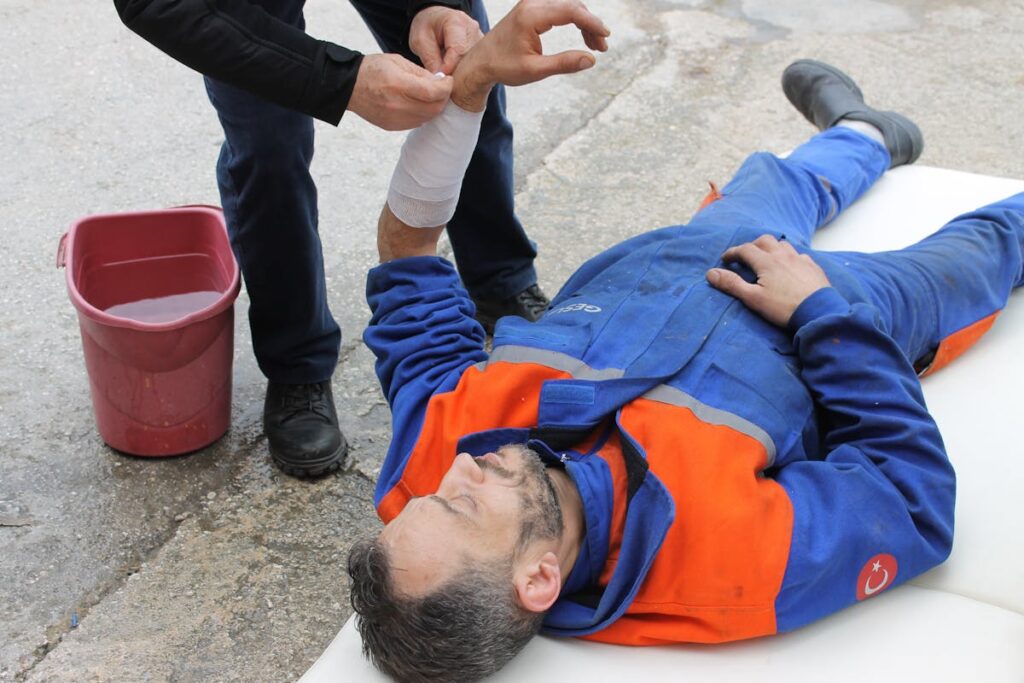Workplace accidents are an unfortunate yet common occurrence, leading to significant physical, emotional, and financial repercussions for both employees and employers. While many of these accidents are attributed to known hazards like falls, machinery mishaps, and chemical exposure, the underlying causes often remain unaddressed. How can we cultivate a safer work environment by identifying and mitigating these risks? The answer lies not only in understanding the root causes but also in implementing robust preventive measures. Join us as we examine this critical issue, shedding light on the path towards safer workplaces.
Understanding Workplace Accidents
While it is often perceived as an unexpected event, a workplace accident is fundamentally an unplanned incident that occurs in a work environment, leading to physical or mental occupational injury. The severity and frequency of these accidents can be considerably influenced by the workplace culture and the level of safety training provided to the employees. A culture that prioritizes safety and encourages open communication about potential hazards can help prevent accidents. Conversely, a lax safety culture may increase the risk. Safety training, on the other hand, equips employees with the knowledge and skills to identify and manage potential risks, as a result, reducing the occurrence of accidents. Understanding these factors is essential in developing effective accident prevention strategies.
Most Common Workplace Injuries
Workplace injuries, a frequent consequence of accidents, manifest in a variety of forms. Ergonomic injuries, a common workplace ailment, usually occur due to improper workstation setup, forcing employees into unnatural postures, which over time can lead to musculoskeletal disorders. These injuries often involve the neck, back, and upper extremities, causing substantial worker discomfort and significant loss of productivity.
Another prevalent workplace injury is repetitive strain, often resulting from continuous, long-term tasks such as typing or assembly line work. These injuries, while initially subtle, can lead to chronic conditions affecting muscles, nerves, and tendons. Businesses must prioritize ergonomic setups and regular breaks to combat these prevalent issues, ensuring employee wellbeing and maintaining operational efficiency.
Slips, Trips and Falls
Slips, trips, and falls represent a significant percentage of workplace accidents, necessitating a closer examination of their prevalent causes. Strategies for preventing such incidents are critical to fostering a safer work environment, as the impact of falling injuries can be severe, leading to long-term physical damage and productivity loss. Consequently, understanding these elements can guide effective measures to mitigate the risks associated with these common workplace accidents.
Common Causes of Falls
A staggering number of incidents in the workplace can be attributed to slips, trips, and falls. The common causes often revolve around poor floor maintenance and inadequate safety signage. When floors are not properly maintained, it paves the way for dangerous conditions like wet or slippery surfaces, uneven floorboards, or cluttered walkways. These factors can easily result in an employee losing their balance and suffering a fall. On the other hand, a lack of visible safety signage can exacerbate these risks. Safety signs play a critical role in warning employees about potential hazards, like wet floors or temporary obstructions. When these signs are absent or not easily noticeable, it increases the likelihood of a fall happening.
Preventing Workplace Accidents
Considering the numerous accidents brought about by slips, trips, and falls, it becomes evident that preventive measures are of utmost importance. A critical first step in prevention is an effective safety training program. This should include detailed instructions on proper usage of equipment, adherence to safety protocols, and swift response to potential hazards. Additionally, regular risk assessment is necessary in identifying areas of potential danger, thereby enabling targeted interventions. These could range from physical modifications like improving lighting or installing anti-slip flooring, to refining operational procedures. Fundamentally, prevention is a proactive, ongoing process, requiring a concerted effort from both management and employees to establish and maintain a safe working environment.
Impact of Falling Injuries
While often overlooked, falling injuries, particularly those resulting from slips, trips, and falls, wield substantial impact on the workplace. Injury statistics reveal that these accidents constitute a significant portion of reported workplace incidents, leading to lost productivity, increased insurance premiums, and potential litigation. The repercussions are not merely physical but also affect the company’s financial health and reputation. Additionally, workplace liability arises when employers fail to maintain safe environments, resulting in such preventable accidents. The liability often leads to hefty compensation payouts, further straining company resources. Consequently, understanding the impact of these incidents is essential in formulating effective prevention strategies, ultimately fostering a safer and more productive work environment.
Machinery-Related Accidents
Machinery-related accidents, often resulting from improper use or lack of safety measures, frequently occur in the workplace. These incidents, which can cause significant injury or even death, can be largely prevented through diligent machinery maintenance and thorough operator training. Machinery maintenance reduces the likelihood of malfunctions, ensuring the equipment operates as intended and thereby mitigating potential hazards. Operator training, on the other hand, empowers employees with the knowledge to operate machinery safely and correctly. It helps them understand the proper procedures, recognize potential risks, and respond effectively to emergencies. This dual approach not only minimizes the incidence of accidents, but it also promotes a culture of safety within the workplace.

Accidents Involving Heavy Lifting
Shifting the focus from machinery-related incidents, another common source of workplace injury arises from accidents involving heavy lifting. These accidents often stem from improper lifting techniques or a lack of ergonomic assessments. It is crucial to understand that lifting with the legs, not the back, can greatly reduce the risk of injuries. Similarly, training employees on the correct use of lifting equipment can further reduce incidents. Ergonomic assessments, on the other hand, can identify potential hazards and suggest improvements in the workplace environment. These assessments can recommend equipment upgrades, changes in workstation design, and employee training programs to guarantee the workforce remains physically capable of handling weighty objects without risk. The goal is to minimize accidents, promote safe lifting techniques and improve overall workplace safety.
Chemical Exposure Incidents
Despite the focus on machinery and physical exertion, a significant number of workplace accidents are attributed to chemical exposure incidents. In many industries, handling chemicals is part of routine operations, making chemical safety a vital aspect of workplace safety measures. Exposure can occur during production, storage, transportation, or waste disposal processes. The severity of these incidents ranges from minor irritations to life-threatening conditions, depending on the exposure limits breached and the type of chemical involved. Chronic exposure, even at low levels, can lead to serious health issues. Hence, regular safety audits, training, and use of protective gear are essential for prevention. The role of employers in ensuring adherence to safety protocols and exposure limits cannot be overstated.
Fire and Explosion Hazards
A significant proportion of workplace accidents are due to fire and explosion hazards. Such incidents often result from a lack of adherence to fire safety regulations or insufficient explosion prevention measures. Fire hazards can stem from various sources, including faulty electrical equipment, improper storage of flammable materials, and careless disposal of smoking materials. Similarly, explosion hazards can arise from the mishandling of explosive substances and gases, as well as from poor ventilation systems that allow the build-up of combustible dust or vapours. Accidents involving fire and explosions can cause severe injuries, extensive property damage, and even loss of life, underscoring the critical importance of understanding and addressing these hazards in the workplace.
Prevention and Safety Measures
To effectively mitigate the occurrence of workplace accidents, adopting thorough prevention and safety measures is paramount. These measures include both safety training and hazard assessment. Safety training equips employees with the knowledge and skills necessary to identify and neutralize potential risks. It also provides them with the tools for responding effectively should an accident occur. Meanwhile, hazard assessment involves a detailed examination of the workplace to identify potential threats to safety. This includes physical hazards, such as faulty equipment, as well as procedural hazards, like inadequate operating procedures. Once identified, steps can be taken to eliminate or mitigate these risks. In sum, a proactive approach to safety can drastically reduce the frequency of workplace accidents.
Frequently Asked Questions
What Are the Psychological Effects of Workplace Accidents on Employees?
Workplace accidents can lead to significant psychological effects on employees, including post-traumatic stress and anxiety disorders. Proper trauma recovery and anxiety management strategies are critical for maintaining mental health and productivity in the aftermath of such incidents.
How Does a Workplace Accident Impact Productivity and Business Operations?
Workplace accidents greatly impact productivity and business operations by increasing accident costs, reducing workforce availability, and necessitating recovery strategies that can disrupt regular operations and potentially lead to financial losses and decreased employee morale.
What Are the Legal Implications if a Workplace Accident Occurs?
When a workplace accident transpires, it can result in significant legal implications, including potential liability issues for the employer and compensation claims from the injured employee, directly influencing the company’s financial and operational stability.
How Can Employee Training Programs Help in Reducing Workplace Accidents?
Effective employee training programs enhance awareness and understanding of safety protocols, thereby greatly minimizing risks. Through improved training effectiveness, employees can adhere to safety standards, reducing the likelihood of accidents and ensuring a safer work environment.
What Should Employees Do Immediately After a Workplace Accident Occurs?
Immediately after a workplace accident, employees should prioritize administering first aid to any injured parties. Following this, it’s essential to promptly report the incident to the appropriate supervisory or management personnel for further action.
